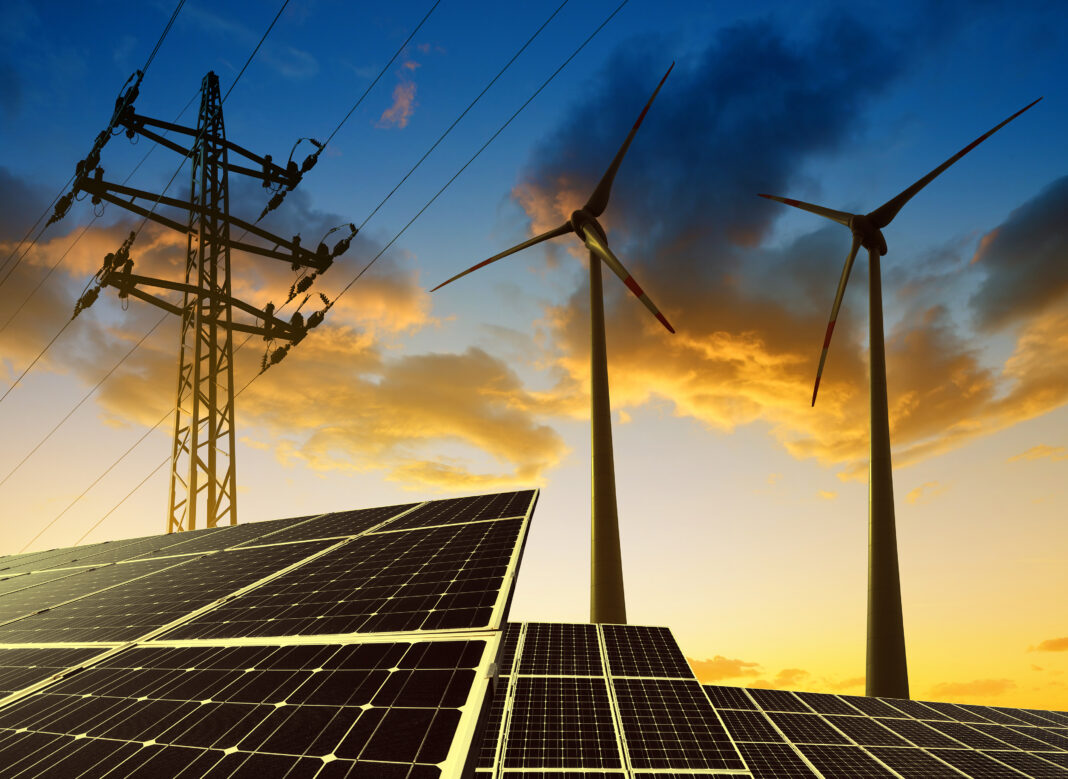A constant theme in this three-part series on renewable energy is that wind and solar electricity generation have a different operating structure compared to the incumbent generation technologies that produce the majority of the world’s electricity. This is particularly the case when compared with hydrocarbon sources oil, natural gas, and coal.
The first two stories in the series are linked here: Renewable energy – renewing hope or struggling to cope?; Renewables Part 2: cost and economic viability.
These structural differences create contrasting strengths and weaknesses. The key benefits of renewable energy sources (sun and wind) are that they are freely available, low in carbon, and, in practical terms, limitless in supply. Principal drawbacks are that they are dispersed and intermittent. We have seen that the dispersed nature of renewable sources means that large amounts of infrastructure are required to gather and concentrate this energy, which comes with both financial and environmental costs. However, it is the challenge of intermittency that is most often referenced when questioning the technological capability of wind and solar to deliver reliable electricity supply to the grid.
Intermittency refers to the fact that wind and solar are both variable and, at least to some degree, unpredictable. The wind does not blow at the same speed all of the time, and the sun does not shine at night, nor sufficiently through clouds. While data on wind patterns can be gathered to produce predictive models, and the path and position of the sun throughout the year are well known, there is residual uncertainty in long-term weather prediction that affects both categories.
From the perspective of electricity supply and demand, this means that wind and solar are not dispatchable, meaning they cannot be dialled up and down as needed to balance changes in electricity demand. Further, due to their unpredictability, they cannot be relied on to provide minimum baseload.
An unspoken tenet of the modern economy is that electricity supply will always be there to meet demand. When we turn on our computers to start work, or grocery store employees place perishable food in a refrigeration unit, it is expected that the power will be there. Combining the intermittent nature of renewables with the instantaneous demand matching required by the modern economy creates obvious challenges.
There are many possible solutions to these challenges, including diversification (spreading generation sites across geographical areas to minimize the impact of local weather), redundancy (using gas-generated power to back up renewables), storage (storing solar energy during the day for use at night), demand shifting (charging an electric car in the middle of the night when demand is low), and even curtailment (paying wind generators not to generate on days when winds are particularly strong is sometimes required to keep the grid in balance).[1][2] Upgrading and modernizing the electricity grid to provide more flexibility is also an option. However, all of these solutions come with additional costs.[3][4]
Levelized costs estimates (LCOE) often used to show that renewables are becoming more competitive frequently do no include all of these costs.[5][6][7] One reason for this is that the cost of integrating renewables into the grid increases as the concentration of renewable energy within the system increases.[8] The grid can easily accommodate a small amount of renewable energy, but the challenges of intermittent supply increase as it becomes a larger proportion of the grid. Because wind and solar penetration is still relatively low in most regions – around 10% in the United States and 8% globally in 2019 – many recent LCOE data points are not associated with high penetration.[9]Furthermore, the costs of integration are often borne by the grid and by consumers rather than investors in generation projects, meaning their investment decisions can be driven by LCOE, leaving the wider system to factor in these additional costs.
Many of the major global energy reports have attempted to generate alternatives to LCOE that account for these additional costs. For example, the US Energy Information Administration (EIA) has created the metric Levelized Avoided Cost of Electricity (LACE), which attempts to measure the value of adding a unit of new generation to the grid by estimating the revenue it would generate in displacing (avoiding) another marginal asset.[10]A similar metric has been developed by the International Energy Association (IEA). Known as the Value Adjusted Levelized Cost of Electricity (VALCOE), this metric factors in the value of additional services provided to the grid by a given generation source. These are services “that are critical to the adequacy, reliability, and quality of electricity supply.”[11] This metric is used to balance out LCOE for generation types that add different values to the grid. The work of the IEA and EIA show that the grid value of natural-gas-fuelled combined cycle gas turbine (CCGT) increases as renewable penetration increases, while the value of renewables generation decreases. This leads to additional natural gas generation being added to the system to support renewables growth even if the LCOE of gas generation is higher.[12] [13] In practical terms, these studies show that under current technological constraints, wind and solar require backup support from conventional sources, with natural gas CCGT currently looking like the most functional and economically sound support technology.
When it comes to real-world integration of renewable energy, the European markets of Denmark and Germany are the most commonly cited examples. Denmark can be misleading because it is a relatively small market tied into the European grid. Although Denmark’s internal penetration is high, its gross capacity is small in comparison to the size of the whole system.[14] For instance, Germany’s wind and solar generation was approximately 10 times that of Denmark as of 2019 (173 terawatt hours to 17 TWh).[15]Due to its scale relative to the European system, Germany likely represents the best example of a major market that has achieved higher penetration of renewables.
The data shows that the German energy transition has not come without significant costs and challenges. A report by McKinsey & Co notes that Germany has, at times, faced “critical” energy security issues when significant shortfalls in supply emerged, requiring the import of power from neighbouring countries at prices far beyond normal market rates.[16]Germany’s renewable energy transition has led to household electricity rates that are 45% higher than the European average.[17]Some of these higher costs can be attributed to the fact that Germany chose to be a renewable energy leader and incentivized these technologies early when costs were higher. While McKinsey & Co. indicates that this comes with some positive economic benefits, including more than 300,000 renewable energy jobs, the data shows that significant contributors to these higher costs are grid interventions and transmission network expansions required to support higher penetration of wind and solar.[18]
Because intermittency has long been seen as the largest technical challenge facing wind and solar, a huge body of academic and technical work has been produced on the costs, impacts, and solutions. While there seems to be no consensus on the theoretical threshold of renewables within the mix, all sources agree that there is only so much wind and solar that can be incorporated in the grid without significant support from dispatchable sources, changes to the structure and flexibility of the grid, or grid-scale storage. The experience of Germany provides real-world support of this view.
The most commonly cited and anticipated solution to the challenge of intermittency is storage. The ability to store solar power during the day and use it at night, or store excess energy on windy days, could remove the technical limitations on renewables within the grid. Along with the falling prices of renewables, this could put wind and solar in dominant positions within the market.
Because grid-scale storage could provide such a definitive solution to the major technical issue associated with renewable energy sources, there is massive investment in research and development in potential storage technologies. This includes pumped hydro-storage,[19]renewables-to-hydrogen,[20] and compression storage,[21]alongside improvements to battery technology. While some of these technologies are being trialed on an industrial scale, and some options appear to be reaching readiness and scale, there is no clear technological solution to grid-scale storage. Furthermore, any successful storage technology will take time and investment to deploy.
See BIG Media’s analysis of the Texas energy crisis Power struggle – data analysis puts Texas energy debacle in perspective and Scott Tinker’s presentation at a U.S. Senate hearing Scientific and realistic views on climate policy – a lesson from Scott Tinker for more on this topic.
The challenge of intermittency is likely not the end of the line for wind and solar. Renewables have formed the majority of new generation installations in recent years, and look set to continue that course in the coming years. Because most of the world’s markets are well below the penetration levels seen in Germany, there is running room for expansion before the challenges and costs associated with intermittency become a significant barrier. The falling cost of battery storage, which has followed a similar learning path to solar PV technology[22]as well as the high level of investment storage development are likely to yield solutions.
However, the challenge of intermittency means that there is a functional limit to the speed at which renewables can be deployed. Claims that the technology already exists to transition to 100% renewable generation are overlooking the complexity of incorporating intermittent sources into existing electricity infrastructure, as the example of Germany has shown. It is important to consider the timeline and scale of the efforts required to modernize and expand the electricity grid, and to develop and deploy grid-scale storage.
[1] https://www.forbes.com/sites/uhenergy/2017/01/24/the-cost-of-wind-and-solar-intermittency/?sh=6717982868de
[2] https://www.thegreenage.co.uk/why-is-intermittency-a-problem-for-renewable-energy/
[3] https://www.forbes.com/sites/uhenergy/2017/01/24/the-cost-of-wind-and-solar-intermittency/?sh=6717982868de
[4] https://ceri.ca/assets/files/CERI%20Electricity%20Report%20-%20April%202020.pdf
[5] https://www.forbes.com/sites/uhenergy/2017/01/24/the-cost-of-wind-and-solar-intermittency/?sh=6717982868de
[6] https://www.eia.gov/outlooks/aeo/pdf/electricity_generation.pdf
[7] IEA – Projected Costs of Generating Electricity – 2020 Edition
[8] https://www.forbes.com/sites/uhenergy/2017/01/24/the-cost-of-wind-and-solar-intermittency/?sh=6717982868de
[9] https://ember-climate.org/data/global-electricity/
[10] https://www.eia.gov/outlooks/aeo/pdf/electricity_generation.pdf , pg3
[11] IEA – Projected Costs of Generating Electricity – 2020 Edition, pg75
[12] IEA – Projected Costs of Generating Electricity – 2020 Edition, pg78
[13] https://www.eia.gov/outlooks/aeo/pdf/electricity_generation.pdf, pg4
[14] https://www.forbes.com/sites/uhenergy/2017/01/24/the-cost-of-wind-and-solar-intermittency/?sh=6717982868de
[15] https://ember-climate.org/data/global-electricity/
[16] https://www.mckinsey.com/industries/electric-power-and-natural-gas/our-insights/germanys-energy-transition-at-a-crossroads
[17] https://www.mckinsey.com/industries/electric-power-and-natural-gas/our-insights/germanys-energy-transition-at-a-crossroads
[18] https://www.mckinsey.com/industries/electric-power-and-natural-gas/our-insights/germanys-energy-transition-at-a-crossroads
[19] https://www.atco.com/en-au/about-us/stories/atco-pumped-hydro-storage-nsw.html
[20] Lessons learnt from the German energy transition – BEE – Sebastian Jasim – 2019
[21] https://highviewpower.com/plants/
[22] RethinkX Rethink Energy


